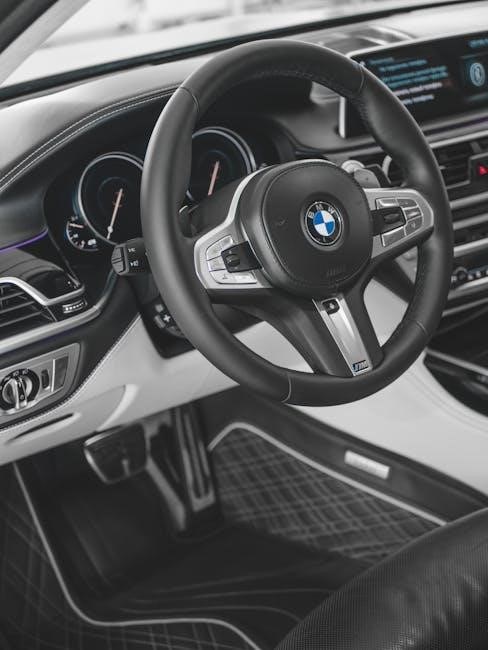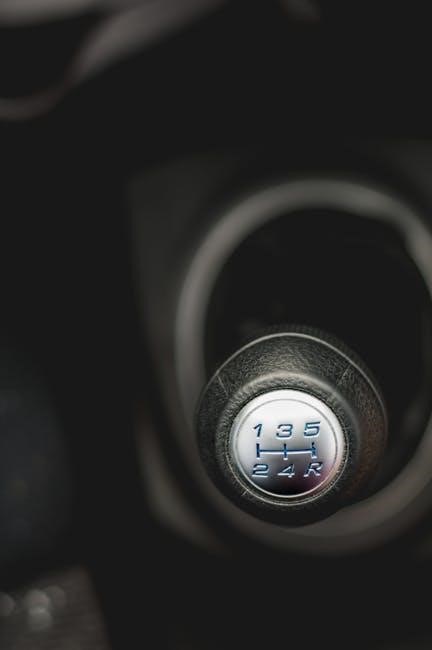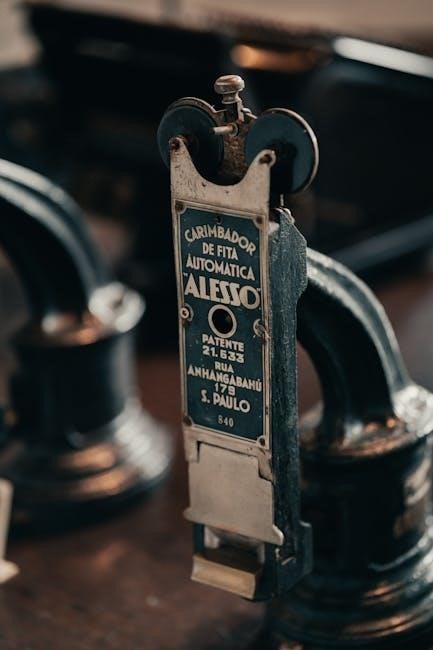
Automatic Starter for Manual Transmission: A Comprehensive Guide
Experience the convenience of remote starting your manual transmission vehicle with advanced systems designed to overcome traditional challenges․ Discover how modern technology enables seamless engine start-up‚ ensuring safety and ease of use for drivers seeking enhanced comfort and control․
An automatic starter for a manual transmission vehicle is a sophisticated system designed to remotely start the engine‚ even in cars with a clutch pedal․ Unlike automatic transmissions‚ manual vehicles require additional components to mimic the clutch engagement process‚ ensuring safe and reliable remote starting․ Modern systems incorporate advanced technology to simulate the clutch pedal‚ allowing drivers to start their cars without physical interaction․ This innovation addresses the unique challenges of manual transmissions‚ providing convenience and ease of use․ These systems are particularly popular in regions with extreme weather conditions‚ where warming up the engine before driving is essential; With proper installation‚ an automatic starter can enhance the driving experience for manual transmission enthusiasts․ However‚ safety and compatibility remain critical considerations‚ as improper installation can lead to potential risks․ This guide explores the functionality‚ benefits‚ and installation requirements of automatic starters for manual vehicles‚ helping drivers make informed decisions․

How Automatic Starters Work with Manual Transmissions
Automatic starters for manual transmissions operate by simulating the clutch pedal engagement and verifying the vehicle is in neutral gear․ These systems use specialized components‚ such as clutch bypass modules‚ to safely remote-start the engine; When activated‚ the remote starter sends a signal to the vehicle’s computer‚ which triggers the ignition and fuel systems․ The clutch bypass module mimics the clutch pedal being pressed‚ allowing the engine to start without manual intervention․ Additionally‚ most modern systems include neutral gear verification to ensure the vehicle is not in motion or in a forward/reverse gear when starting remotely․ This prevents potential accidents or unintended movement․ The process typically involves integrating the remote starter with the vehicle’s ignition‚ clutch‚ and transmission systems․ Advanced models may also include features like engine speed monitoring and automatic shut-off if the clutch pedal is pressed without the driver’s key present․ These technologies ensure a seamless and safe remote-starting experience for manual transmission vehicles․
Benefits of Installing an Automatic Starter in a Manual Transmission Vehicle
Installing an automatic starter in a manual transmission vehicle offers a wealth of benefits that enhance convenience‚ comfort‚ and security․ For instance‚ drivers can remotely start their engine‚ allowing the vehicle to warm up or cool down before driving‚ which is especially useful in extreme weather conditions․ This feature eliminates the need to physically turn the key or press the ignition button‚ making the process more efficient․ Additionally‚ remote starters can improve safety by reducing the risk of theft‚ as modern systems often include anti-theft features that prevent unauthorized use․ They also provide peace of mind for drivers who want to ensure their engine is ready to go when they are․ Furthermore‚ automatic starters can simplify the driving experience by automating the startup process‚ which is particularly advantageous for drivers who value a seamless and hassle-free experience․ Overall‚ these systems bridge the gap between traditional manual transmissions and modern convenience technologies‚ offering a practical solution for drivers seeking enhanced functionality and ease of use․
Challenges of Installing an Automatic Starter in a Manual Transmission Vehicle
Installing an automatic starter in a manual transmission vehicle presents unique challenges that require careful consideration․ One of the primary difficulties is the need to simulate the clutch pedal engagement‚ as manual transmissions rely on this mechanism to start the engine․ This often necessitates additional components‚ such as a clutch bypass module‚ to safely replicate the clutch press and ensure proper engine start-up․ Another challenge is the potential safety risks associated with remote starting a manual vehicle․ If the system fails to verify the vehicle is in neutral or the parking brake is engaged‚ it could lead to unintended movement‚ posing a hazard․ Moreover‚ some mechanics may be hesitant to install remote starters in manual vehicles due to these complexities‚ which can limit availability and increase costs․ Finally‚ ensuring compatibility with the vehicle’s specific clutch safety switch and transmission system requires precise wiring and configuration‚ adding to the installation’s complexity․ These challenges highlight the importance of professional installation and advanced safety features to mitigate risks․
Key Components of an Automatic Starter System for Manual Transmissions
A comprehensive automatic starter system for manual transmissions comprises several essential components to ensure safe and reliable operation․ The clutch bypass module is a critical component‚ as it simulates the clutch pedal press to enable remote starting without driver intervention․ Additionally‚ the system includes neutral gear verification sensors to confirm the vehicle is in neutral gear‚ preventing accidental movement․ A remote control with extended range and multi-vehicle control capabilities enhances user convenience․ The control module acts as the brain of the system‚ processing signals from the remote‚ interacting with the vehicle’s ECU‚ and managing the clutch bypass․ Fail-safe mechanisms are incorporated to ensure the system defaults to a secure state in case of any malfunction․ Furthermore‚ advanced systems may include smartphone integration for app-based control and encrypted communication to prevent unauthorized access․ These components work together seamlessly to provide a reliable‚ secure‚ and user-friendly remote starting experience for manual transmission vehicles․
Compatibility and Requirements for Manual Transmission Vehicles
Ensuring compatibility is crucial when installing an automatic starter in a manual transmission vehicle․ Most modern remote start systems are designed to work with manual transmissions‚ but specific requirements must be met․ The vehicle must have a neutral gear verification feature to ensure the car is in neutral before starting․ Additionally‚ a clutch pedal bypass module is often required to simulate the clutch press‚ enabling remote start functionality․ Compatibility varies by vehicle make‚ model‚ and year‚ so it’s essential to verify the system’s compatibility list․ Some systems may require additional wiring or software adjustments to integrate with the vehicle’s electronics․ Diesel engines‚ in particular‚ may need specialized settings due to their unique start-up requirements․ Always consult the installation manual or a professional to ensure the system is configured correctly for your vehicle․ Proper installation ensures safety and prevents potential issues‚ such as unintended movement or engine damage․

Step-by-Step Installation Guide for an Automatic Starter in a Manual Transmission Car
Installing an automatic starter in a manual transmission car requires careful planning and precise execution․ Begin by gathering all necessary tools and components‚ including the remote start kit‚ wiring harness‚ and bypass modules․ Step 1: Disconnect the battery to ensure safety․ Step 2: Access the vehicle’s wiring system by removing panels under the dash and around the gearshift․ Identify the ignition‚ starter‚ and clutch pedal wires using a wiring diagram․ Step 3: Install the clutch pedal bypass module to simulate clutch engagement‚ a critical step for manual transmissions․ Step 4: Connect the remote start system to the ignition and starter wires‚ following the manufacturer’s instructions․ Step 5: Integrate the neutral gear verification sensor to ensure the vehicle is in neutral before starting․ Step 6: Mount the remote start brain in an accessible location and connect all components․ Step 7: Test the system to ensure proper functionality‚ checking remote start‚ clutch simulation‚ and neutral gear verification․ Finally‚ Step 8: Reconnect the battery and verify all features work seamlessly․ Always refer to the installation manual for specific instructions and consider professional help if unsure․
Safety Considerations and Potential Risks of Remote Start in Manual Vehicles
While remote starters offer convenience‚ they pose unique safety risks in manual transmission vehicles․ The primary concern is the potential for unintended movement if the vehicle is not properly secured in neutral gear․ Improper installation can lead to the car rolling or starting in gear‚ causing accidents or damage․ Additionally‚ bypassing the clutch pedal safety switch may compromise critical fail-safes designed to prevent accidental starts․ There is also a risk of fire or electrical damage if wiring is not handled correctly․ Some systems require additional motion sensors to detect vehicle movement‚ adding another layer of complexity․ Furthermore‚ liability issues arise if the vehicle is stolen or involved in an accident due to remote start misuse․ Modern systems often include features like neutral gear verification and automated clutch engagement to mitigate risks‚ but these are not foolproof․ Always ensure proper installation and adherence to safety protocols to minimize potential hazards․
Top-Rated Remote Start Systems for Manual Transmission Vehicles
When selecting a remote start system for a manual transmission vehicle‚ it’s essential to choose a model designed to handle the unique challenges of manual transmissions․ Compustar remote starters are highly recommended‚ as they offer advanced features like clutch bypass modules‚ ensuring safe and reliable starts․ Viper remote start systems are another top choice‚ providing cutting-edge technology with smartphone integration and robust security features․ Excalibur remote starters are also popular‚ known for their failsafe mechanisms and compatibility with manual vehicles․ Avital systems are praised for their ease of use and affordability‚ making them a great option for budget-conscious drivers․ These systems are engineered to address the specific needs of manual transmissions‚ offering features like neutral gear verification and automated clutch engagement․ Always ensure the system is compatible with your vehicle’s make and model‚ and consult a professional installer for a seamless setup․ These top-rated systems provide convenience‚ safety‚ and peace of mind for manual transmission vehicle owners․
Cost Implications of Installing an Automatic Starter in a Manual Car
Installing an automatic starter in a manual transmission vehicle can vary significantly in cost‚ depending on the system’s complexity and features․ Basic remote start systems for manual cars typically range from $200 to $600‚ while advanced models with additional features like smartphone integration or multi-vehicle control can cost upwards of $1‚000․ The installation process for manual vehicles is generally more complex than for automatics‚ often requiring extra components like clutch bypass modules or neutral gear verification systems; These additions can increase the overall cost by $100 to $300․ Labor costs also vary‚ with professional installers charging between $100 and $300‚ depending on the system’s requirements․ DIY kits are available but may not include all necessary components‚ potentially leading to additional expenses․ High-end systems with advanced security features or diesel engine compatibility can further inflate the price․ While the convenience of a remote starter is appealing‚ it’s important to weigh the costs against the benefits‚ especially for manual transmission vehicles‚ which often require more specialized solutions․

Professional Installation vs․ DIY: What’s Recommended?
When it comes to installing an automatic starter in a manual transmission vehicle‚ the decision between professional installation and DIY hinges on expertise and safety․ Manual transmissions present unique challenges‚ such as clutch bypass and neutral gear verification‚ which require precise adjustments․ Professional installers have the experience and tools to handle these complexities‚ ensuring proper system integration and safety․ DIY installations‚ while possible for experienced enthusiasts‚ carry risks like improper wiring‚ which can lead to electrical issues or even vehicle damage․ Additionally‚ bypassing critical safety features‚ such as the clutch pedal interlock‚ can create dangerous scenarios․ Many professionals recommend avoiding DIY for manual vehicles due to these risks․ While DIY kits are available‚ they often lack the specialized components needed for manual transmissions‚ leading to potential failures․ Given the technical demands and safety concerns‚ professional installation is strongly recommended for manual vehicles․ This ensures reliability‚ proper functionality‚ and adherence to safety standards‚ making it a worthwhile investment for long-term satisfaction and peace of mind․
User Experiences and Reviews of Automatic Starters in Manual Cars
Users of automatic starters in manual transmission vehicles report mixed experiences‚ highlighting both convenience and challenges․ Many appreciate the comfort of remote starting‚ especially in extreme weather‚ as it allows the engine to warm up or cool down before driving․ However‚ some note that the installation process can be complex‚ often requiring additional components like clutch bypass modules․ Reviews often emphasize the importance of professional installation to avoid issues like faulty wiring or improper system configuration․ Satisfaction tends to be higher among those who opt for reputable brands‚ such as Compustar‚ which offer advanced features like neutral gear verification․ A common theme in reviews is the need for careful consideration of safety features‚ as bypassing the clutch pedal can pose risks if not done correctly․ Overall‚ users agree that while the technology is innovative and beneficial‚ it requires careful setup and adherence to manufacturer guidelines to ensure reliability and safety․ Positive reviews often highlight the seamless integration and enhanced convenience‚ while negative experiences typically stem from improper installation or unrealistic expectations about system capabilities․
Future Trends and Innovations in Remote Start Technology for Manual Transmissions
The future of remote start technology for manual transmission vehicles promises exciting advancements‚ blending convenience‚ safety‚ and connectivity․ One emerging trend is the integration of artificial intelligence (AI) to enhance system operation‚ such as predictive maintenance and adaptive start-up sequences․ Smartphone app enhancements will likely dominate‚ offering features like geofencing‚ custom start-up profiles‚ and real-time vehicle diagnostics․ Vehicle-to-everything (V2X) communication could also play a role‚ enabling remote starters to interact with other smart devices for a seamless driving experience․
Another innovation is the development of advanced clutch simulation systems‚ which will improve compatibility with a wider range of manual transmission vehicles․ Biometric authentication‚ such as fingerprint or facial recognition‚ may become standard for added security․ Additionally‚ eco-friendly features‚ like optimized engine warm-up times to reduce emissions‚ are expected to gain traction․ As technology evolves‚ remote start systems for manual cars will become more intuitive‚ reliable‚ and integrated with modern automotive advancements‚ offering drivers unparalleled convenience without compromising safety or performance․
These innovations aim to address the unique challenges of manual transmissions while setting new standards for remote start technology in the automotive industry․
